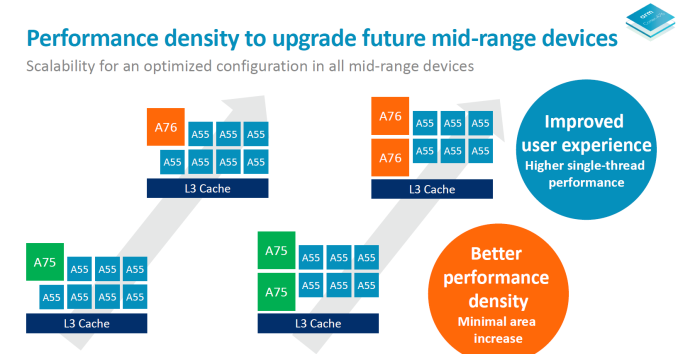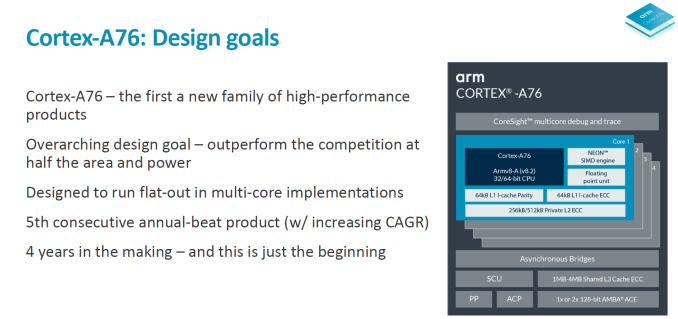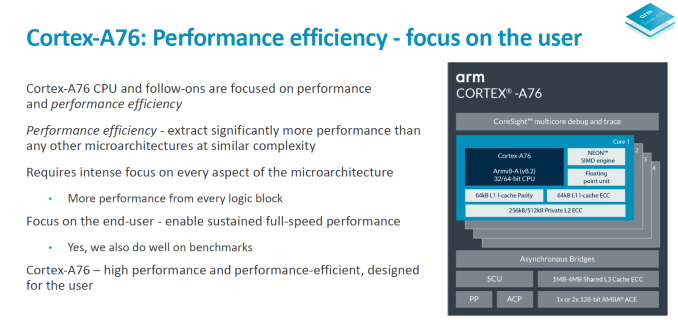Arm's Cortex-A76 CPU Unveiled: Taking Aim at the Top for 7nm
by Andrei Frumusanu on May 31, 2018 3:01 PM EST- Posted in
- CPUs
- Arm
- Smartphones
- Mobile
- SoCs
- Cortex-A76

Another year, another TechDay from Arm. Over the last several years Arm’s event has come as clockwork in the May timeframe and has every time unveiled the newest flagship CPU and GPU IPs. This year is no exception as the event is back on the American side of the Atlantic in Austin Texas where Arm has one of its major design centres.
Two years ago during the unveiling of the Cortex A73 I had talked a bit more about Arm’s CPU design teams and how they’re spread across locations and product lines. The main design centres for Cortex-A series of CPUs are found in Austin, Texas; Cambridge, the United Kingdom, and Sophia-Antipolis in the south of France near Nice. For the last two years the Cortex A73 and Cortex A75 were designs that mainly came out of the Sophia team while the Cortex A53 and more recently the A55 were designs coming out of Cambridge. This means that we haven’t seen any recent designs coming out of Austin and the last of the “Austin family” of CPUs were the A57 and A72.
The project being worked on in Austin had been hyped up for several years – I remember even as early as the A73 release back in 2016 the company had pulled forward some elements from an advanced future microarchitecture on the back-end pipelines, especially on the FP/SIMD side. The Cortex A75 was further remarked as pulling more elements from this new mysterious project.
Today we can finally unveil what the Austin team has been working on – and it’s a big one. The new Cortex A76 is a brand new microarchitecture which has been built from scratch and lays the foundation for at least two more generations for what I’ll call “the second generation of Austin family” of CPUs.
The Cortex A76 is important for Arm for a design perspective as it represents a new start from a clean sheet. It’s rare for IP claim to be able to do this as it represents a great resource and time investment and if it weren’t for the Sophia design team taking over the steering wheel for the last two generations of products it wouldn’t have been reasonable to execute. The execution of the CPU design teams should be emphasised in particular as Arm claims this is the 5th generation “annual beat” product where the company delivers a new microarchitecture every new year. Think of it as an analogue to Intel’s past Tick-Tock strategy, but rather Tock-Tock-Tock for Arm with steady CAGR (compound annual growth rate) of 20-25% every generation coming from µarch improvements.
So what is the Cortex A76? In Arm’s words, it’s a “laptop-class” performance processor with mobile efficiency. The vision of the A76 as a laptop-class processor had been emphasised throughout the TechDay presentation so it seems Arm is really taking advantage of the large performance boost of the IP to cater to new market segments such as the emerging “Always connected PCs” which Qualcomm is spearheading with their SoC platforms.
The Cortex A76 microarchitecture has been designed with high performance while maintaining power efficiency in mind. Starting from a clean sheet allowed the designers to remove bottlenecks throughout the design and to break previous microarchitectural limitations. The focus here was again maximum performance while remaining within energy efficiency that is fit for smartphones.
In broad metrics, what we’re promised in actual products using the A76 is the follows: a 35% performance increase alongside 40% improved power efficiency. We’ll also see a 4x improvements in machine learning workloads thanks to new optimisations in the ASIMD pipelines and how dot products are handled. These figures are baselined on A75 configurations running at 2.8GHz on 10nm processes while the A76 is projected by Arm to come in at 3GHz on 7nm TSMC based products.
The new CPU is naturally still compatible with DynamIQ’s common cluster topology and Arm envisions designs to be paired with Cortex A55s as the little more power efficient CPUs. The configuration scalability of the DynamIQ IP again was reiterated and we were presented with example configurations such as 1+7 or 2+6 with either Cortex A75 or A76 CPU IP. This presentation slide was one of the rare ones where Arm referred to the area size of the A76, pointing out that the A75 still had better PPA and thus might still be a valid design choice for companies, depending on their needs. One comparison that was made during the event is that in terms of area, three A76’s with larger caches would fit inside the size of a Skylake core – all while within 10% of the IPC of the Intel CPU, but obviously there’s also process node scaling considerations to take into account.
A standout claim is that Arm aims to outperform the competition at half the area and half the power. Arm was slightly beating around the bush here in what it considers the competition, but generally the answer was that it was considering everybody the competition. Taking into account Intel, AMD or Samsung it’s actually not that hard to imagine Arm beating them in PPA as historically the company always had the smallest CPU designs and that directly translates into more efficient microarchitectures.
Before we get into more detailed breakdowns of the performance and power improvements and what I’m expecting to happen into products, let’s see the microarchitectural improvements on the core and how Arm managed to extract this much performance while maintaining power efficiency.















123 Comments
View All Comments
serendip - Thursday, May 31, 2018 - link
Does anyone actually use the full performance of the A11 or A12 in daily tasks? To me, it's pointless to have a power hungry and fast core just for benchmarks. Just make a slightly slower core with less power usage for quick bursts like app loading or Web page rendering, while much slower and more efficient cores handle the usual workload.jOHEI - Thursday, May 31, 2018 - link
ARM's objectives is to make CPU's that go into a cluster of 4+ another 4 small ones.What Apple has does is Making bigger cores >2 times the size of an ARM core and have 1.5x the performance of the Said core. That same CPU is made for very high Power consumption at maximum load and Apple tweaks the ammount of time it stays in those high clocks. Thus its easier to make a laptop chip-tablet and phone. Because you just reuse the same CPU for all of them, maybe add a few cores to the laptop version and tweak the power settings and its relatively easy.
jOHEI - Thursday, May 31, 2018 - link
Forgot to mention that Apple goes for 2 core clusters, not 4. So they must have significantly better single core performance to matchup against the Conpetition.name99 - Friday, June 1, 2018 - link
Just to correct that you are somewhat living in the past with your numbers.ARM no longer cares about 4-sized clusters; that was an artifact of big.LITTLE (and one of the constraints that limited that architecture's performance). The successor to big.LITTLE, brand-named dynamIQ, does not do things in blocks of 4 anymore.
Likewise Apple first released 3 CPUs in a SoC with the A8X. The A10X likewise has three CPUs. It's entirely likely (though no-one knows for sure) that the A11X (or A12X if the 11X is skipped) will have 4 large cores.
BurntMyBacon - Friday, June 1, 2018 - link
Due to ARM's licensing model, they have every incentive to push designs that cater to more cores. They have little incentive to push single threaded performance any more than necessary as this would result in few cores being licensed due to space and power constraints. I'm not fully convinced that the whole big.LITTLE (and derivative) philosophy was the best way to go either. It could be that it got close enough to what advanced power management could do with the benefit of providing a convincing case for ARM CPU designers to use double the cores or more. When Intel was still in the market, they demonstrated that a dual core chip with clock gating, power gating, power monitoring, dynamic voltage and frequency scaling, and other advanced power management features could provide superior single thread performance and comparable multithread performance in a similar power envelop to competing ARM designs with double the cores (all while burdened with the inefficient x86 decoder). Apple also had good success employing a similar philosophy until their A10 design. Though, it is not necessarily causal, it is interesting to note that they've had more trouble keeping within their thermal and power constraints on their latest A11 big.LITTLE design.Note: I don't have any issue with asymmetric / heterogeneous CPUs. I'm just not convinced that they are adequate replacements for good power management built into the cores. DynamIQ does seem to be a push in the right direction allowing simultaneous usage of all cores, providing hooks for accelerators, and providing fine grained dynamic voltage and frequency scaling. This makes a lot of sense when you can assign tasks to processors (or accelerators) with significantly better proficiency for the task in question. Switching processors for no other reason than it is lower power, however, just sounds like the design team had no incentive to further optimize their power management on the high performance core.
name99 - Friday, June 1, 2018 - link
Again a correction.Apple's problems with the A10 and A11 are NOT problems of power management; they are problems of CURRENT DRAW. Power management on the chips works just fine (and better than ever; high performance throttling tends to occur less with each successive generation, and it used to be possible to force reboot an iPhone if you got it hot enough, now that seems impossible because of better power management).
Current draw, on the other hand, is not something the SoCs were designed to track. And so when an aging battery is no longer able to provide max current draw (when everything on the SoC is lined up just wrong) then not enough current IS provided, and the system reboots.
This is definitely a flaw in the phone as a whole, but it's a system-wide flaw, and you can imagine how it happened. The SoC was designed assuming a certain current drive because no-one thought about aging batteries, because no-one (in Apple or outside) had hit the problem before.
I expect the A12 will have the same PMU that, today, monitors temperatures everywhere to make sure they remain within bounds, ALSO tracking a variety of proxies for current draw, and will be capable of throttling performance gradually in the face of extreme current draw, just like performance is throttled gradually in the face of extreme temperature.
eastcoast_pete - Friday, June 1, 2018 - link
Different design and use philosophies. Apple's mobile chips are designed to be able to deliver short bursts of very high processing power (opening a complex webpage, switching between apps), and throttle back to Okay fast during the remainder. That requires apps and OS to be tightly controlled and behave really well - one bad app that doesn't behave and keeps driving the CPU hard for longer periods and your phone would get hot (thermal throttling) , plus your battery would run down in a jiffy. For ARM & Co on Android/Linux, it makes more sense to have smaller, less powerful cores, manage energy consumption through other means (BigLittle etc), and increase performance by increading the number of cores/threads. Basically, if you really want to upscale the performance of stock ARM designs for a laptop or similar, you could dump the "little" cores and go for an octacore or decacore BIG, so all A76 cores. Might be interesting if somebody tries it.serendip - Friday, June 1, 2018 - link
It's not so simple - small A55 cores seem to work better in a quad or hexacore config, whereas A75s are best left in a dual core config at most because their perf/watt is poor. No point having a phone that's crazy fast but overheats and runs out of battery quickly.Apple's use of powerful but power-hungry cores could also affect the longevity of older phones. Older batteries might not be able to supply enough power for a big core running at full speed.
BurntMyBacon - Friday, June 1, 2018 - link
The fact that Apple is able to use an even larger and more power hungry core and a (marginally?) smaller battery should tell you that it is doable. Though, you are correct in saying it's not simple. The fact of the matter is, Apple has implemented much better power management features than ARM to allow for their cores to run at higher peak loads while needed and then being able to throttle down to lower power draw very quickly. ARM simply didn't design the A75 to do low power processing. The A75 is designed to rely on the A55 for low power processing as this provides an incentive to sell more core licenses.BillBear - Friday, June 1, 2018 - link
Traditionally, Apple builds a big ass core and clocks it low.It wasn't until FinFET made it to mobile chips that they started clocking higher.
>Apple has always played it conservative with clockspeeds in their CPU designs – favoring wide CPUs that don’t need to (or don’t like to) clock higher – so an increase like this is a notable event given the power costs that traditionally come with higher clockspeeds. Based on the underlying manufacturing technology this looks like Apple is cashing in their FinFET dividend, taking advantage of the reduction in operating voltages in order to ratchet up the CPU frequency. This makes a great deal of sense for Apple (architectural improvements only get harder), but at the same time given that Apple is reaching the far edge of the performance curve I suspect this may be the last time we see a 25%+ clockspeed increase in a single generation with an Apple SoC.
https://www.anandtech.com/show/9686/the-apple-ipho...
Qualcomm has been building small cores and vendors have been clocking them (with corresponding voltage increases) high.
Remember all the Android vendors getting caught red handed changing clockspeeds when they detected benchmarks running?